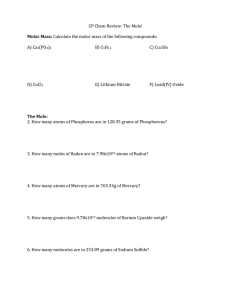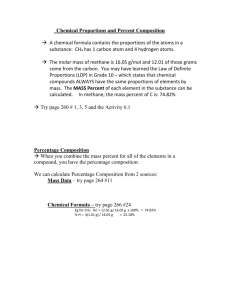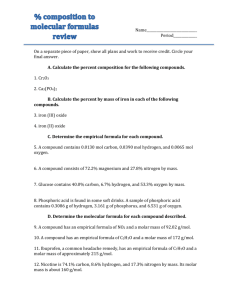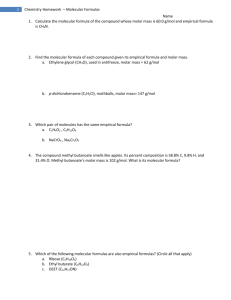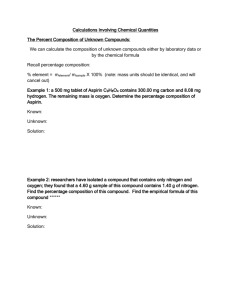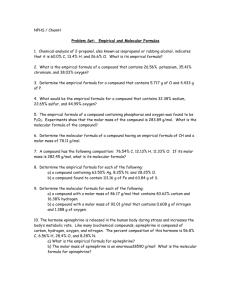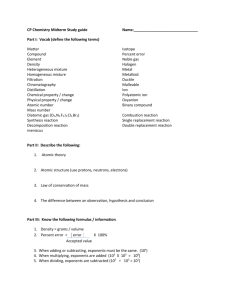Empirical and Molecular Formulas
advertisement
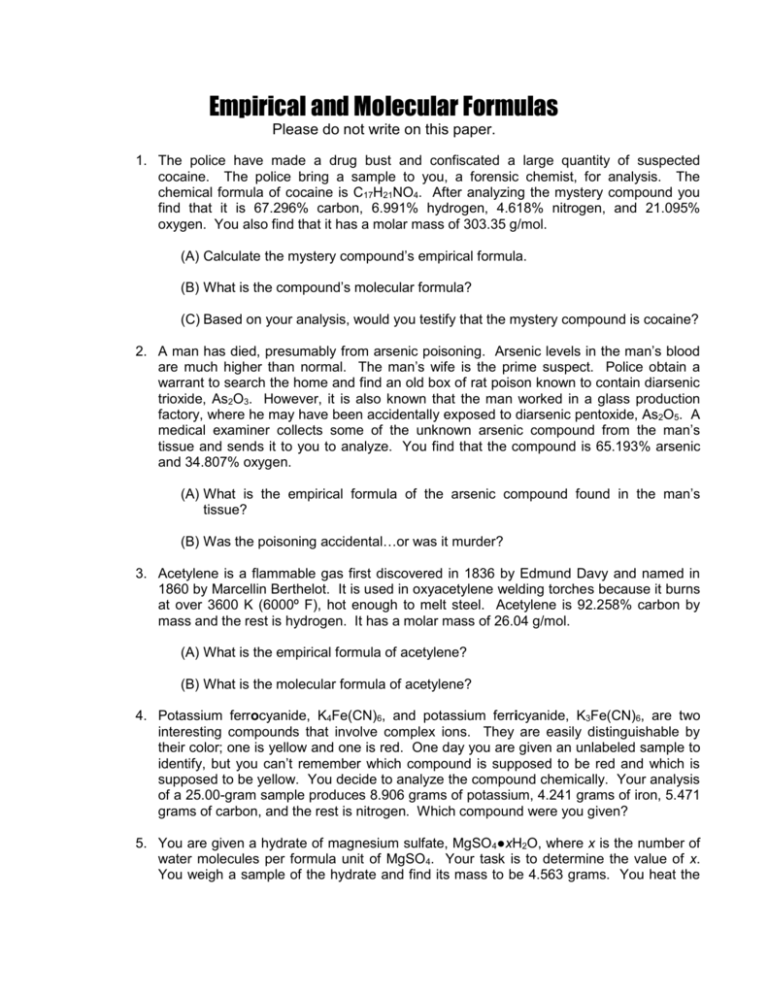
Empirical and Molecular Formulas Please do not write on this paper. 1. The police have made a drug bust and confiscated a large quantity of suspected cocaine. The police bring a sample to you, a forensic chemist, for analysis. The chemical formula of cocaine is C17H21NO4. After analyzing the mystery compound you find that it is 67.296% carbon, 6.991% hydrogen, 4.618% nitrogen, and 21.095% oxygen. You also find that it has a molar mass of 303.35 g/mol. (A) Calculate the mystery compound’s empirical formula. (B) What is the compound’s molecular formula? (C) Based on your analysis, would you testify that the mystery compound is cocaine? 2. A man has died, presumably from arsenic poisoning. Arsenic levels in the man’s blood are much higher than normal. The man’s wife is the prime suspect. Police obtain a warrant to search the home and find an old box of rat poison known to contain diarsenic trioxide, As2O3. However, it is also known that the man worked in a glass production factory, where he may have been accidentally exposed to diarsenic pentoxide, As2O5. A medical examiner collects some of the unknown arsenic compound from the man’s tissue and sends it to you to analyze. You find that the compound is 65.193% arsenic and 34.807% oxygen. (A) What is the empirical formula of the arsenic compound found in the man’s tissue? (B) Was the poisoning accidental…or was it murder? 3. Acetylene is a flammable gas first discovered in 1836 by Edmund Davy and named in 1860 by Marcellin Berthelot. It is used in oxyacetylene welding torches because it burns at over 3600 K (6000º F), hot enough to melt steel. Acetylene is 92.258% carbon by mass and the rest is hydrogen. It has a molar mass of 26.04 g/mol. (A) What is the empirical formula of acetylene? (B) What is the molecular formula of acetylene? 4. Potassium ferrocyanide, K4Fe(CN)6, and potassium ferricyanide, K3Fe(CN)6, are two interesting compounds that involve complex ions. They are easily distinguishable by their color; one is yellow and one is red. One day you are given an unlabeled sample to identify, but you can’t remember which compound is supposed to be red and which is supposed to be yellow. You decide to analyze the compound chemically. Your analysis of a 25.00-gram sample produces 8.906 grams of potassium, 4.241 grams of iron, 5.471 grams of carbon, and the rest is nitrogen. Which compound were you given? 5. You are given a hydrate of magnesium sulfate, MgSO 4●xH2O, where x is the number of water molecules per formula unit of MgSO4. Your task is to determine the value of x. You weigh a sample of the hydrate and find its mass to be 4.563 grams. You heat the compound until it is completely dehydrated and weigh it again. anhydrous MgSO4 is 2.228 grams. The mass of the (A) How many grams of water were lost from the hydrate? (B) How many moles of water were lost from the hydrate? (The molar mass of water is 18.0153 g/mol). (C) How many moles of MgSO4 remain? (The molar mass of MgSO4 is 120.369 g/mol). (D) What was the value of x? (E) Write the empirical formula of the hydrate, including the correct number of water molecules. 6. Oxalic acid is a moderately weak acid found in many rust-proofing products. It can exist as a hydrate. When it is analyzed in the laboratory, it is found to be 19.051% carbon, 1.602% hydrogen, 50.761% oxygen, and 28.594% water. Its molar mass is 127.08 g/mol. (A) What is the empirical formula of oxalic acid? (B) What is the molecular formula? 7. Calculate the empirical formula of the following: (A) 15.8% carbon and 84.2% sulfur (B) 43.6% phosphorus and 56.4% oxygen (C) 28.7% K, 1.5% H, 22.8% P, and 47.0% O 8. Calculate the molecular formula for the following: (A) empirical formula CH, molar mass = 78 g/mol (B) empirical formula NO2, molar mass = 92.02 g/mol (C) caffeine, 49.5% C, 5.15% H, 28.9% N, 16.5% O, molar mass = 195 g/mol


